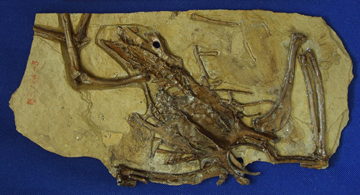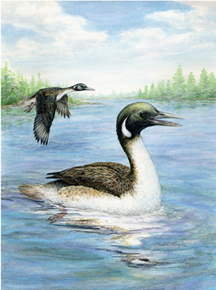Geotimes

Untitled Document

Web Extra
Thursday, June 15, 2006
 Ancient
bird fossil makes a splash
Ancient
bird fossil makes a splash
Recent expeditions in a remote area of China have unearthed unusually well-preserved
fossils of an ancient bird that lived between 105 million and 115 million years
ago. The fossils of the surprisingly modern-looking bird suggest that today's
birds may have originated from an aquatic ancestor.
A nearly complete fossil skeleton of
Gansus yumenensis is one of several that reveals the 110-million-year-old
bird's anatomy is strikingly similar to that of modern birds. The fossils also
indicate G. yumenensis was equipped for life in an aquatic habitat. Photo
is by Hai-lu You, courtesy of the Chinese Academy of Geological
Sciences.
In 1981, paleontologists searching for fossil fish in northwestern China's
Gansu province accidentally discovered the fossilized foot of a bird they named
Gansus yumenensis. However, the foot revealed only minimal information
about G. yumenensis, and questions about the animal remained unanswered
until a team of researchers, led by Hai-lu You of the Chinese
Academy of Geological Sciences, reinvestigated the Gansu area in 2004 and
2005 and found the new batch of G. yumenensis fossils.
In the June 16 issue of Science, the team describes fossil remains of
five G. yumenensis individuals that form almost a complete skeleton,
minus the skull and the first few neck vertebrae. Most of the bones are still
in their original, 3-D form, unlike many fossils which get crushed over time.
The exceptional condition of the remains gives scientists an unprecedented view
into the life of the extinct bird. "We finally have a glimpse, with these
new fossils, of what Gansus yumenensis looked like," says Julia
Clarke, an avian paleontologist at North Carolina State University in Raleigh
who is not associated with the expeditions.
G. yumenensis, as it turns out, looks quite modern. "With a few exceptions,
you could put any of its bones next to those of a modern bird and you would
be hard pressed to see major differences," says Jerald Harris of Dixie
State College in Utah, who was part of the expedition team. Like today's birds,
G. yumenensis has a thin, flexible wishbone and a large crest running down the
middle of its breastbone. By comparison, more primitive birds, which were less
sophisticated in their ability to fly than modern birds, have thick, heavy wishbones
and only small crests on their breastbones. G. yumenensis also has long arms
that bear asymmetrical feathers. These features indicate that "Gansus
could fly in the same way modern birds can," Harris says.
 The similarity
of G. yumenensis to modern birds came as a surprise: Previously, such
advanced anatomical features had been seen only in birds that lived during and
after the late Cretaceous period — within the last 100 million years. "In
short, no one expected to find a bird this modern in rocks this old," Harris
says, referring to the shale formation where the team made its discovery. The
shale dates to the early Cretaceous period, which occurred between 100 million
and 145 million years ago. As a result of the finding, G. yumenensis
now has the distinction of being "the oldest-known bird that is really,
really modern in its anatomy," he says.
The similarity
of G. yumenensis to modern birds came as a surprise: Previously, such
advanced anatomical features had been seen only in birds that lived during and
after the late Cretaceous period — within the last 100 million years. "In
short, no one expected to find a bird this modern in rocks this old," Harris
says, referring to the shale formation where the team made its discovery. The
shale dates to the early Cretaceous period, which occurred between 100 million
and 145 million years ago. As a result of the finding, G. yumenensis
now has the distinction of being "the oldest-known bird that is really,
really modern in its anatomy," he says.
As such, G. yumenensis may help fill in gaps in the branch of the evolutionary
tree that gave rise to today's birds. Specifically, scientists are looking to
G. yumenensis for present-day evidence of whether modern birds originated in
aquatic or terrestrial habitats.
An artist's reconstruction shows
Gansus yumenensis in a lake in China's Gansu province. The bird probably
had the ability to dive and swim underwater, much like modern loons or grebes.
Illustration by Mark A. Klingler, courtesy of the Carnegie Museum of Natural
History.
"The most primitive living birds — for example, ostriches, rheas,
and chickens — tend to be terrestrial" and therefore would seem to
hint that today's birds got their start on land, says Matthew Lamanna, a research
team member from the Carnegie Museum of Natural History in Pennsylvania. Yet
two other features of G. yumenensis — webbed feet and a large crest
on its lower leg bone that would have provided a strong anchor for leg muscles
— suggest the bird was aquatic and had the ability to dive and swim underwater
like loons or grebes. According to You's research team, this supports the idea
that modern birds actually originated in water habitats.
Nonetheless, the G. yumenensis find does not definitively rule out the
idea of a land-based ancestor for modern birds. According to Sylvia Hope, a
specialist in the early fossil record of modern birds at the California Academy
of Sciences in San Francisco, the rarity of terrestrial birds in the fossil
record of the early Cretaceous period "may be due to the known poor potential
for preservation of delicate bird skeletons in terrestrial habitats." Still,
she says, the new G. yumenensis specimens represent a significant finding.
A future priority for You's team is to better pinpoint the age of the G. yumenensis
remains, currently estimated to be between 105 million and 115 million years
old. Determining the age of G. yumenensis with respect to other fossil birds,
Harris says, "particularly others on the branch leading to modern birds,
will give us a good handle on how quickly many of the anatomical features we
associate with modern birds evolved."
Jennifer Yauck
Links:
Chinese
Academy of Sciences
"Penguins endure extinction event," Geotimes,
June 2006
Back to top
Untitled Document

 The similarity
of G. yumenensis to modern birds came as a surprise: Previously, such
advanced anatomical features had been seen only in birds that lived during and
after the late Cretaceous period — within the last 100 million years. "In
short, no one expected to find a bird this modern in rocks this old," Harris
says, referring to the shale formation where the team made its discovery. The
shale dates to the early Cretaceous period, which occurred between 100 million
and 145 million years ago. As a result of the finding, G. yumenensis
now has the distinction of being "the oldest-known bird that is really,
really modern in its anatomy," he says.
The similarity
of G. yumenensis to modern birds came as a surprise: Previously, such
advanced anatomical features had been seen only in birds that lived during and
after the late Cretaceous period — within the last 100 million years. "In
short, no one expected to find a bird this modern in rocks this old," Harris
says, referring to the shale formation where the team made its discovery. The
shale dates to the early Cretaceous period, which occurred between 100 million
and 145 million years ago. As a result of the finding, G. yumenensis
now has the distinction of being "the oldest-known bird that is really,
really modern in its anatomy," he says. 
 Ancient
bird fossil makes a splash
Ancient
bird fossil makes a splash
